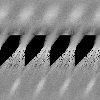Eric Weeks
- personal pages - picturesCellular Automata Phase Diagrams |
weeks@physics.emory.edu |
Eric Weeks
- personal pages - picturesCellular Automata Phase Diagrams |
weeks@physics.emory.edu |
![]()
![]()
These pictures relate to phase diagrams which I generated a long time ago, and I no longer know exactly which are which.




When I was at the 1995 Complex Systems Summer school at the Santa Fe Institute, I worked on cellular automata with real numbers describing the state of each cell. I wrote a program that would generate CA's with the restriction that the state of each cell was a real number between 0 and 1. The update rule was restricted to:
new x_{n} = A x_{n-1} + B x_{n} + C x_{n+1} + D mod 1 .
I quickly generated a large number of CA runs starting from a random initial state. Many of them looked "boring" -- the final state would be a uniform gray color, or worse, a uniform black color (black = 0). But some looked very interesting.
I then worked on the meta-level question, what values of the parameters A, B, C, and D would give me "interesting" CA rules. I have a very nice four-dimensional phase space plot but unfortunately the limits of HTML and most conventional monitors prevent me from showing you this four-dimensional picture. :-) Actually, I added the further restriction A = C, to simplify matters further.
Various cuts through the four-dimensional phase space are shown below. The random appearance of parts of the plot is due to the random initial conditions.
For this first plot, D ranges from -2 to 2 (horizonal axis), A = C and range from -2 to 2 (vertical axis; -2 at top of the plot), and B=0.2 is fixed. In this plot, black is zero, white is 1/2. Given that the arithmetic of the rule is done mod 1, the plot is periodic in D.
Here is another phase diagram. In this case, A = C = 0.2 is fixed, D ranges from -2 to 2 (horizonal axis), and B ranges from -2 to 2 (vertical axis; -2 at top). Again, black is zero, white is 1/2, and the plot is periodic in D.
 Click here to see a large version of this phase diagram.
Click here to see a large version of this phase diagram.
For this last phase diagram, D = 0.2 is fixed. A = C is plotted on the horizontal axis, and ranges from -2 to 2. B is plotted on the vertical axis, and ranged from -2 to 2 (-2 is at the top of the plot). Black is zero, white is 1/2, and this plot isn't periodic.
 Click here to see a large version of this phase diagram.
Click here to see a large version of this phase diagram.
![]()
 Click here for information about the software I use to make cellular
automata.
Click here for information about the software I use to make cellular
automata.